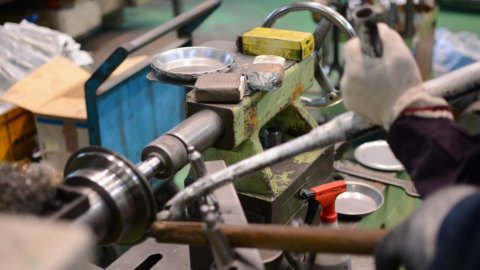In productivity the medium-sized Italian manufacturing companies not only did they outperform the large ones, but they also outperformed their French or German counterparts. This is demonstrated by the fact that in recent years about 210 have passed into foreign hands, a quarter of which to these countries. An extraordinary result if we consider that our manufacturing as a whole is instead lagging behind by 17,9% compared to France and Germany. But if we want to keep running on the paths of innovation and internationalization we need to put our hand to governance. This is what emerged in the XXI Report "Leaders of change: Italian medium-sized enterprises in the fifth industrial revolution” of Unioncamere, Mediobanca Study Area and Tagliacarne Study Center.
“Medium-sized Italian industrial enterprises are the backbone of Italian family capitalism, as the experience of the last 25 years has shown. They can rightly be defined as the locomotive of our entrepreneurial system, representing a factor of resilience and continuous modernization of the production system, thanks to a high capacity to invest in the dual green and digital transition, with respect to which human capital represents the most important intangible asset ”. The president of Unioncamere said it, Andrew Priest.
Italian medium-sized enterprises and the relationship with foreign countries
Their productivity is 21,5% higher than in Germany and France. On the other hand, in comparison with foreign competitors, our medium-sized enterprises perceive themselves as disadvantaged in terms of cost structure (50,5%), of efficiency of the public administration (30,2%) and di quality of the country's infrastructure (22%).
An interesting aspect concerns the fact that wealth and employment are mainly produced in Italy. 88,2% do not have a production site abroad and only 3% produce more than 50% of their output in foreign plants. Reshoring seems to weigh little, with 88,8% using foreign suppliers, obtaining on average 25% of their supplies. Furthermore, the share of sales destined abroad is equal to 43,2% of the turnover.
The overtaking of the medium-sized ones on the large ones despite a worse tax system
In comparison with the large manufacturing companies, from 1996 to today, the averages have recorded better performances from many points of view: they have obtained a turnover growth more than double (+108,8% against +64,4%), hit a major increased productivity (+53% compared to +38,6%) and guaranteed a better remuneration for work (+62,4% medium, +57% large).
However, the report notes that the best performances were achieved in a context that was not always favourable. This is the case of the taxman: the effective tax rate of medium-sized companies is now around 21,5% against 17,5% of large companies, but in the past the spread was even wider, over 8 points in 2011.
If in the last decade medium-sized enterprises had had the same tax burden as the large ones, they would have obtained more resources for 6,5 billion euros.
Increasing turnover but there is the obstacle of generational handover
With a rebound in turnover in 2021 (+19%), the prospects for 2022 are also more than positive (+6,3%). Looking to the future, however, the generational relay risks slowing down its progress: 47,2% of medium-sized enterprises have resolved the generational change while 17,4% are facing it, but have not completed the process and 32,5% of medium-sized companies take the opportunity to insert external managers in the generational changeover.
The main challenges: governance and the dual digital and green transition
However, the many positive profiles of medium-sized enterprises must not ignore the important challenges that remain in the field. The need to be aligned with Esg requirements brings the focus back to governance. Some good practices still have limited diffusion: the self-regulatory code is adopted by 35,3%, the presence of independent directors on the board is limited to 24,8%, the existence of a CEO outside the family occurs in 16,8% of cases.
Geopolitical uncertainty puts the continuity of supplies at risk and medium-sized enterprises intend to remedy this through a mix of diversifying the number of suppliers (79,7%) and increasing those located nearby (29,8%), including national ones ( 27,4%).
With regard to the double transition digital and green, 52% of medium-sized companies that have invested in the last five years expect to exceed pre-Covid production levels in 2022. A share that drops to 35% in the case of those who have invested only in digital and to 31% for companies that have focused only on green, up to 21% where no investment has been made in this direction. An element of competitiveness that medium-sized enterprises seem aware of: more than 60% expect, in fact, to invest in 2022 and green technologies in the three-year period 24-4.0, while just 15% estimate that they will focus only on the digital transition and another 13 % only on the green.
But also the social sustainability rewards medium-sized enterprises: 62% invest in corporate welfare, 61% involve their employees in innovation activities (new processes, products and company organizational methods, etc.), 51% in the quality of human relations and 51% collaborates with the cultural sector to increase the well-being of the territory.
And the PNRR? 4 out of 10 medium-sized companies are at a standstill
59% of medium-sized enterprises focus on the PNRR: 40% have already activated projects in direct support of entrepreneurial systems, while 19% plan to do so.
However, there is another 41% who do not think of taking advantage of opportunity provided for in the Plan. There are both internal and external factors that push more or less to take action in this sense. The former concern human capital, the latter the relationship with institutions and universities, especially when both actors are involved.
Focus on the agri-food chain
The survey also analyzes the performance of medium-sized enterprises belonging to the supply chain manufacturing agri-food Italian company (595) who have demonstrated great resilience in the face of the pandemic. Between 2019 and 2020, turnover grew by 1,5%, thanks above all to exports (+3,6%); national sales closed with a +0,8%. 2021 recorded +11% on the previous turnover and +16% on exports while, for 2022, increases of 5,1% are expected for total sales and 4,9% across the border. Of course, much will depend on the ever-changing geopolitical context.





